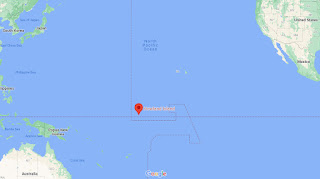If the name “Howland Island” rings a bell with you at all,
it’s probably because it was the spot in the Pacific Ocean that Amelia Earhart
was trying to locate during her around-the-world flight. She didn’t find it. Her
plane disappeared on July 2, 1937. But something I didn’t know is that the
Japanese bombed Howland Island on December 8, 1941, one day after their attack
on Pearl Harbor.
Howland Island is located about 1700 miles southwest of
Hawaii. It lies roughly halfway on a direct line from Hawaii to Australia,
which made it a good spot to refuel in the early days of transoceanic flying.
That is if you could find it. The island is only 1.4 x .55 miles,
approximately one square mile in size. Howland came up on my radar when I was
watching an excellent YouTube video on World War II in the Pacific. In the list
of locations that the Japanese attacked on December 7-8 that we all know,
(Hawaii, the Philippines, Wake, Guam, etc.) the narrator included Howland
Island. Since I had not heard this before I had to look into it.
Howland Island was on sailing maps by the late 1700s. It is
believed that Captain Bligh landed on the island for a short stay in 1789 after
being set adrift by the
mutineers of the HMS Bounty. Whalers in the
early 1800s knew where it was. The United States gained possession of Howland
Island in 1856, but really the island was a hazard to navigation (there were multiple
shipwrecks on the island) and a place to harvest bird guano. In 1935, colonists
came to the island to establish both a scientific research facility and to
solidify American claims to this and other South Pacific islands. The belief
was that the island would be used as part of a chain of refuel stops for
commercial aircraft. In fact, WPA funds were used to build an airstrip on the
island specifically for Earhart’s flight.

The Japanese attacked the island on December 8, 1941, with
14 bombers based in the Kwajalein Islands. Two colonists were killed in the
attack. There was extensive damage to the airstrip. Two days later a Japanese
submarine shelled the island, destroying the remaining buildings that had survived
the first attack. Two times a single bomber flew over and dropped bombs on the
island, even though there was nothing left to bomb. The U.S. Navy rescued the
survivors on January 31, 1942. A battalion of U.S. Marines occupied Howland in
September of 1943 and the island was called Howland Naval Air Station. But the
war moved on and it was abandoned in May 1944.
Today, Howland is an uninhabited, unorganized, territorial
possession of the United States. In 1974, a wildlife refuge was created that
included Howland and 12 miles of ocean around it. Entry to the Howland Island
National Wildlife Refuge is only by a special permit granted by the U.S. Fish and
Wildlife Service.




1 comment:
Great article on Howland Island. Thanks for sharing it. By Gregg L. Friedman MD
Post a Comment